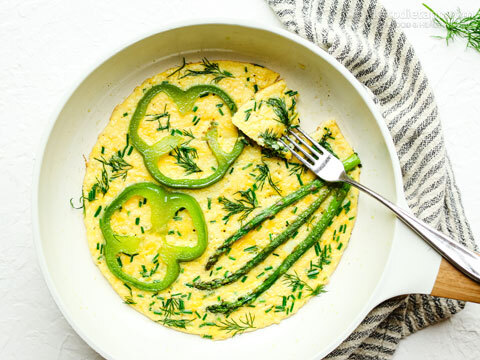Martina Šlajerová's Blog, page 3
August 9, 2024
15 Easy High-Protein Low-Carb Lunches You Can Make Ahead

Are you looking for delicious, easy-to-make recipes that fit perfectly into your low-carb, high-protein lifestyle? Whether you're following a keto diet or simply prioritizing protein, this roundup of 15 recipes is sure to satisfy your taste buds while keeping you on track. From make-ahead meals to quick lunches, these dishes are designed to simplify your meal prep and make your keto journey a breeze.
Caprese Frittata

This Caprese Frittata combines tomatoes, basil, and mozzarella with eggs for a quick and easy low-carb meal. Perfect for breakfast or brunch, it's finished under the broiler and topped with fresh basil for extra flavor.
Low-Carb Greek Feta Burgers

These Low-Carb Greek Feta Burgers are packed with flavor and protein. Made with ground beef, crumbled feta, and Mediterranean spices, they are juicy and satisfying. Perfect for a quick meal, these burgers can be served with a fresh salad or wrapped in lettuce for a keto-friendly option.
Salmon Broccoli Cakes

These Salmon Broccoli Cakes are a tasty and nutritious option for a low-carb meal. Made with canned salmon, fresh or frozen broccoli, and seasoned with garlic, red onion, lemon juice, parsley, and dill, these cakes are packed with flavor. They can be prepared in under 30 minutes and are perfect for meal prep. Serve with tartar sauce and a side salad for a complete meal.
Savory Protein Waffles

These Savory Protein Waffles (aka chaffles) are made with almond flour and cheese, offering a low-carb, high-protein alternative to traditional waffles. Perfect for breakfast or a quick snack, they can be used just like bread to make sandwiches, or topped with avocado and a poached egg for added protein and flavor. They are great for meal prep and can be stored for later use.
Yum Yum Chicken Slaw

This Keto Yum Yum Chicken Slaw combines shredded chicken with a mix of red and green cabbage, red onion, and carrot, all tossed in a creamy homemade Yum Yum Sauce. The sauce is made with mayonnaise, tomato paste, Sriracha, and a touch of sweetener, creating a flavorful and satisfying low-carb meal. Perfect for a quick and easy lunch or dinner, this slaw is both nutritious and delicious.
Tuna Cakes

These Low-Carb Tuna Cakes are quick to prepare and perfect for a protein-packed meal. Made with canned tuna, eggs, red onion, Parmesan cheese, and coconut flour, they are flavorful and satisfying. Serve them with a simple side salad or a mayo-based dip for a complete meal. They are ideal for meal prep and can be stored in the fridge for up to three days.
Creamy Chicken Salad with Cilantro Ranch Dressing

This Creamy Chicken Salad is packed with shredded chicken, celery, and red onion, all mixed in a tangy cilantro ranch dressing. Made with paleo mayo, sour cream, lime juice, and fresh herbs, this salad is both flavorful and satisfying. Perfect for meal prep, it can be served on a bed of lettuce for a quick and healthy meal.
Loaded Egg Salad

This Keto Loaded Egg Salad takes a classic egg salad and adds bacon, tomatoes, green onions, and cheddar cheese for a filling, protein-packed meal. Perfect for lunch, it can be enjoyed in lettuce cups or between slices of keto bread. The creamy base is made with avocado oil mayo and mustard, providing a delicious flavor that complements the added ingredients.
Mediterranean Meatball Lunchbox Bowls

These Mediterranean Meatball Lunchbox Bowls are perfect for meal prep and quick lunches. The meatballs are made with ground chicken or turkey, Parmesan cheese, garlic, and Italian herbs. Served with fresh veggies like cucumber, tomatoes, bell peppers, and red onion, and drizzled with a homemade Tomato & Basil Dressing, these bowls are a nutritious and flavorful option. They can be prepared ahead of time and stored in the fridge for convenience. Looking for more meatball recipes? Check these out!
Mackerel Patties

These Easy Keto Mackerel Patties are perfect for a quick, protein-rich meal. Made with canned mackerel, almond flour, and simple seasonings, they are easy to prepare and ideal for meal prep. These patties can be served on their own, with a side of vegetables, or with a dipping sauce like garlic mayonnaise. They are also freezer-friendly, making them a convenient option for busy days.
Veggie Labneh Meal Prep Bowls

These Veggie Labneh Meal Prep Bowls are a perfect vegetarian option. They feature marinated labneh cheese balls coated in dukkah, served with spiced cauliflower rice and roasted vegetables. The recipe is ideal for meal prep, allowing you to enjoy a ready-to-go, nutritious lunch throughout the week. You can also make a dairy-free version by following the recipe's modifications. Need more vegetarian protein? Simply add some hard-boiled eggs.
Greek Chicken Bowls

These Greek Chicken Bowls are perfect for a nutritious and flavorful meal. They feature marinated chicken cubes cooked until golden, served with cauliflower rice, Greek salsa made from cucumber, tomatoes, red onion, olives, and feta cheese, and topped with a refreshing Tzatziki sauce. Ideal for meal prep, these bowls can be assembled in advance and stored for several days, making them a convenient option for busy schedules.
Chicken Fajita Salad

This Chicken Fajita Salad combines grilled chicken thighs marinated in a cilantro lime dressing with fresh bell peppers, onions, avocado, and jalape��os. Served on a bed of crisp lettuce and topped with the same flavorful marinade as a dressing, this salad is perfect for meal prep and can be stored for several days. It's a spicy, satisfying, and nutritious option for anyone following a keto diet.
Cheesy Low-Carb Tuna Casserole

This Cheesy Low-Carb Tuna Casserole is a comforting and satisfying meal made with canned tuna, broccoli, and cauliflower, all mixed in a rich, creamy cheese sauce. It's topped with mozzarella or cheddar cheese and baked until golden and bubbly. Perfect for a quick weeknight dinner, this casserole can be made ahead and stored in the fridge for up to five days.
Chicken Pecan Salad

This Low-Carb Chicken Pecan Salad is a quick and easy dish made with chopped cooked chicken, parsley, pecans, red onion, and celery. It's mixed with a dressing of avocado oil mayonnaise, lemon juice, and wholegrain mustard, and served on lettuce leaves. This salad is perfect for meal prep as it can be stored in the refrigerator for up to five days. It's a nutritious option for a light lunch or snack.
July 12, 2024
Air Fryer Keto Chocolate Pavlova

Have you ever made a dessert in your air fryer? If not, try this easy Keto Chocolate Pavlova!
This low-carb, sugar-free, and gluten-free dessert is perfect all year round - from summer gatherings and birthdays, to holidays and other occasions.
It's made with fluffy meringue, whipped cream, and fresh berries. Give it a try and impress your friends and family with a healthier dessert option.
Recipe Tips and Swaps
This Keto Chocolate Pavlova is naturally nut-free and can be made dairy-free by using coconut cream or yogurt instead of dairy cream.
Don't waste the egg yolks! Use any leftover egg yolks to make a batch of Garlic Mayonnaise or Lemon Curd!
Topping Variations
You can add any berries you like, or skip them and use some grated dark chocolate. Here are some more options for your Keto Chocolate Pavlova:
Chocolate Cream: Add a tablespoon of cacao powder to the whipped cream for a chocolatey topping.
Dark Chocolate Shavings: Sprinkle some dark chocolate shavings or add dark chocolate chips on top for extra flavor and texture. You can use 85-90% dark chocolate, or sugar-free chocolate (white, milk or dark).
Boozy Cream Topping: Mix in a tablespoon of rum or whiskey to the whipped cream for a boozy twist. Speaking of boozy chocolate cream, you may also like these Boozy Keto Chocolate Mousse Bowls!
Tips for Oven Baked Pavlova
This Keto Chocolate Pavlova was one of my first desserts made in the Air Fryer. Don't have an air fryer? Follow these tips to make keto Pavlova made in the oven!
More Air Fryer Keto Recipes
I've been using my my Air Fryer for all sorts of dishes. Here are some of my favorites:
Crispy Garlic Chicken
Keto Vanilla Berry Pavlova
Roasted Ranch Radishes



Sardine Egg Cups, Bacon & Cheese Egg Cups and Spinach & Feta Egg Cups
Butterflied Chicken Drumsticks with Chimichurri Sauce
Bacon & Cheese Egg Cups
Mexican Stuffed Chorizo Burgers




Preparation time
Hands-on: 10 minutes
Overall: 1 hour
Nutritional values (per quarter)
Total Carbs7.8grams
Fiber2.4grams
Net Carbs5.4grams
Protein3.9grams
Fat23.4grams
of which Saturated14.7grams
Energy257kcal
Magnesium25mg (6% RDA)
Potassium172mg (9% EMR)
Macronutrient ratio: Calories from carbs (9%), protein (6%), fat (85%)
Macronutrient ratio: Calories from carbs (9%), protein (6%), fat (85%)
Ingredients (makes 4 servings)
2 large egg whites
1/4 tsp cream of tartar or 1 tsp apple cider vinegar
5 tbsp powdered Allulose (50 g/ 1.8 oz)
2 tbsp raw cacao powder or Dutch process cocoa powder (12 g/ 0.4 oz)
1 cup heavy whipping cream (240 ml/ 8 fl oz)
1 tsp sugar-free vanilla extract
2 tbsp powdered Allulose or low-carb sweetener of choice (20 g/ 0.7 oz)
1 cup fresh berries of choice - strawberries, raspberries, blackberries and/or blueberries (140 g/ 5 oz)
Instructions
Crack the eggs and separate the egg whites from the yolks. Place the egg whites in a large clean bowl or mixer.
Note: Use leftover egg yolks to make a batch of Garlic Mayonnaise or Lemon Curd!
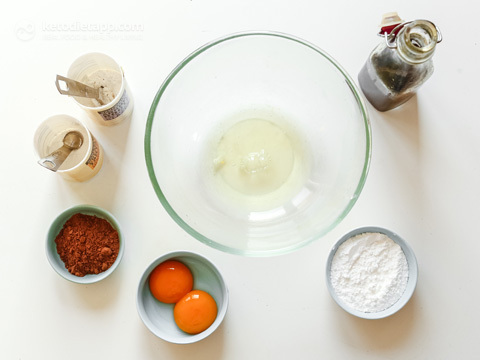
Beat on medium-low speed for 2 minutes until foamy. Add cream of tartar (or apple cider vinegar).
Gradually add the sweetener, one tablespoon at a time, beating until stiff peaks form. Sift in cacao powder and gently fold with a rubber spatula without deflating the egg whites.
Note: For best results use Allulose. Unlike Erythritol-based sweeteners, Allulose will caramelize with no aftertaste and no crystallization once chilled.)
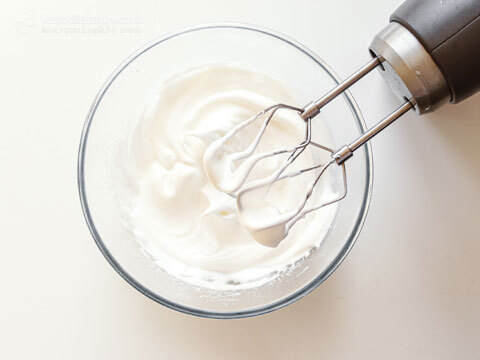
Place parchment paper in the air fryer. Spoon the mixture into a round shape, leaving a 1-inch gap from the sides.
Create a nest in the middle to hold the whipped cream and berries after baking.
Set the air fryer to 120 °C/ 250 °F and cook for 40 minutes, checking once or twice.
Note: I used the "Roast" settings on my air fryer. For oven baking instructions, see this recipe.
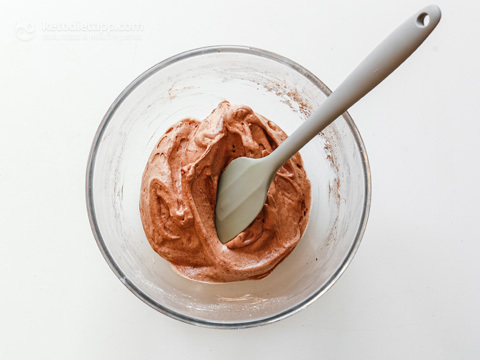
Once cooked, open the air fryer and let it cool down completely before removing from the air fryer and adding the topping.
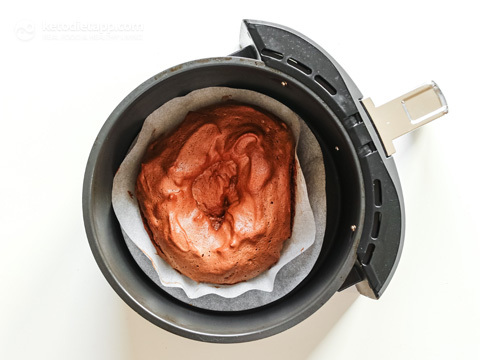
Whip the cream with 2 tablespoons of Allulose and vanilla. (Optionally, add a tablespoon of cacao powder for chocolate cream.)
Top the cooled meringue with whipped cream and fresh berries. (Optionally, add dark chocolate shavings or a tablespoon of rum/whiskey for a boozy cream topping.)
Slice and serve immediately. To store, keep the baked meringue in an airtight container separate from the cream in the fridge for up to 3 days. Assemble right before serving.

July 9, 2024
How To Balance Electrolytes When You Go Low-Carb

Maintaining the right balance of sodium, magnesium, and potassium is crucial for preventing symptoms of the keto-flu, including headaches, muscle cramps, fatigue, and mood swings. Proper hydration and monitoring your body���s signals can help manage and maintain this balance effectively.
Sodium: Aim for 4-6 grams (4,000 to 6,000 mg) of sodium per day using mineral-rich salts.
Magnesium: Aim for at least 400 mg of magnesium daily. To meet this goal, consider supplementing with 200-400 mg of magnesium glycinate or citrate. A deficiency in magnesium can lead to muscle spasms, insomnia, and increased food cravings.
Potassium: Include potassium-rich foods like avocados, meat, and fish in your diet. Consult a doctor before taking potassium supplements, especially if on blood pressure medications. Try to get at least 2,000 mg, or ideally 4,700 mg a day.
Hydration: Drink at least 8-10 cups of water daily to prevent dehydration and support electrolyte balance. Pay attention to your body's signals such as headaches, muscle cramps, and fatigue, and adjust your electrolyte intake as needed.
Table of Contents
Why Electrolytes Are Essential on a Low-Carb Diet
Sodium
Summary
Magnesium
Magnesium Citrate: An Effective and Often Overlooked Option
Summary
Potassium
Summary
Hydration and Electrolyte Balance
7 Tips for Balancing Electrolytes
1. Incorporate Electrolyte-Rich Foods
2. Monitor Your Body's Signals
3. Take it Easy During the Adaptation Phase
4. Avoid Common Pitfalls
5. Use Quality Supplements
6. DIY Electrolyte Drink
7. Long-Term Maintenance
Switching to a low-carb or keto diet can bring great benefits like weight loss and better blood sugar control. However, it���s essential to pay attention to your electrolyte balance to avoid common issues like the "keto flu." Many people experience symptoms like muscle cramps and headaches, which can be demotivating and even make them give up.
Electrolytes, such as sodium, magnesium, and potassium, are crucial for your body���s functions, including nerve signaling, muscle contractions, and hydration. When you cut down on carbs, your body loses more sodium, which can throw off your electrolyte balance and lead to symptoms like headaches, fatigue, and muscle cramps.
In this post, we���ll explore why keeping your electrolytes balanced is so important on a low-carb diet, highlight the key electrolytes to watch, and offer tips on how to maintain the right levels to stay healthy and feel your best.
Why Electrolytes Are Essential on a Low-Carb Diet
Electrolytes are crucial minerals for many bodily functions. When you switch to a low-carb or keto diet, your body undergoes changes that make electrolyte balance even more important.
Lower carb intake reduces insulin levels, causing your kidneys to excrete more sodium. This loss can disrupt the balance of other electrolytes like potassium and magnesium, leading to symptoms known as the "keto flu" ��� headaches, fatigue, muscle cramps, and mood swings.
Proper electrolyte intake helps mitigate these symptoms. Sodium aids in nerve function and fluid balance, magnesium supports muscle and nerve function, and potassium is vital for heart health and muscle contractions. By maintaining these electrolytes, you can prevent the keto flu and ensure a smoother transition into ketosis.
Sodium
Sodium is essential for nerve function, fluid balance, and muscle contractions. When you reduce carbs, your body loses more sodium through urine. Low sodium can lead to headaches, fatigue, and nausea.
To maintain sodium levels, use mineral-rich salts like sea salt or pink Himalayan salt instead of highly processed iodized table salt. Aim for 4-6 grams (4,000 to 6,000 mg) of sodium per day, roughly 2-2.5 teaspoons of sea salt. Dr Volek and Phinney recommend not to exceed 8,000 mg of sodium per day.
Summary
Importance: Essential for nerve function, fluid balance, and muscle contractions.
Symptoms of Deficiency: Headaches, nausea, fatigue.
How to Get Enough: Use mineral-rich salts like sea salt or pink Himalayan salt, avoid highly processed table salt.
Recommended Intake: 4-6 grams (4,000 to 6,000 mg) of sodium per day (about 2-2.5 teaspoons of sea salt). Add up to 2,000 mg if you sweat a lot, you're active or live in hot climates.
Magnesium
Magnesium is essential for muscle and nerve function, heart health, and bone strength. Modern water supplies often lack magnesium, making deficiencies common, especially on a low-carb diet. Symptoms of low magnesium include muscle cramps, insomnia, and fatigue.
One interesting aspect of magnesium is its role in calcium regulation. Magnesium helps control how calcium is transported and used in the body. Without enough magnesium, calcium can build up in soft tissues, leading to muscle cramps and spasms.
Research indicates that magnesium can help reduce food cravings; deficiencies in this mineral are linked to increased cravings. Taking a daily supplement of 600 milligrams of magnesium has been shown to significantly reduce these cravings. ( Askari et al, 2021) Either way, you should be getting at least 400 milligrams of magnesium every day.
Make sure to include magnesium-rich foods, and consider supplementing magnesium. Here's a list of the best magnesium supplements,. Magnesium glycinate, citrate, chloride, malate, taurate, transdermal and salts/baths are best options. Avoid magnesium oxide and aspartate.
Magnesium Citrate: An Effective and Often Overlooked Option
Many people avoid magnesium citrate due to its potential laxative effects, but when used correctly, it is a highly effective magnesium supplement. Magnesium citrate is well-absorbed, supports muscle and nerve function, regulates blood sugar, , aids in better sleep, and provides constipation relief by drawing water into the intestines.
To avoid the laxative effects, it's crucial to stick to the recommended dosage of 200-400 mg daily. Within this range, you can benefit from its high absorption and health advantages without significant gastrointestinal discomfort.
Summary
Importance: Vital for muscle and nerve function, heart health, and bone strength.
Symptoms of Deficiency: Muscle spasms, insomnia, fatigue, increased food cravings.
Magnesium-Rich Foods: Leafy greens, nuts, seeds, and dark chocolate.
How to Get Enough: Supplement with 200-400 mg of magnesium daily, avoid supplements with fillers like maltodextrin. Magnesium glycinate and citrate are some of the best options.
Potassium
Potassium is crucial for maintaining muscle mass, preventing cramps, and regulating heart function. Low potassium levels can lead to symptoms including low energy, heavy legs, salt cravings, and dizziness. Dehydration from sweating or diarrhea can also lower potassium levels. Adequate potassium intake is essential for preserving lean muscle mass during weight loss.
The Adequate Intake (AI) for potassium is 4,700 milligrams per day for adults, which is the same as the Recommended Dietary Allowance (RDA). This amount meets the nutritional needs of most healthy individuals. The Estimated Minimum Requirement (EMR) is 2,000 mg, representing the minimum needed to prevent deficiency symptoms, though this can vary based on individual health conditions and dietary factors.
To maintain potassium balance, include potassium-rich foods in your diet. Supplements may be needed for some, but consult your doctor first, especially if you're on blood pressure medication, as high potassium intake can interact with these medications.
Summary
Importance: Helps maintain muscle mass, prevents cramps, regulates heart function.
Symptoms of Deficiency: Low energy, heavy legs, dizziness, salt cravings.
Potassium-Rich Foods: Avocados, meat, fish, and certain vegetables.
How to Get Enough: Consider supplements if dietary intake is insufficient. Try to get at least 2,000 mg, or ideally 4,700 mg a day.
Caution: Consult a doctor before significantly increasing potassium intake, especially if on blood pressure medications.

Hydration and Electrolyte Balance
While following a low-carb diet, maintaining proper hydration is crucial. Carbohydrates help retain water, so when you reduce carb intake, your body excretes more water along with electrolytes.
Drinking enough water helps prevent dehydration and supports the balance of electrolytes. Aim to drink at least 8-10 cups of water daily, although the exact number varies for individuals, or more if you are active or in a hot climate.
7 Tips for Balancing Electrolytes
1. Incorporate Electrolyte-Rich Foods
Include foods high in sodium, magnesium, and potassium in your diet. Examples include:
Sodium: Drink bone broth and use mineral-rich salts like sea salt and pink Himalayan salt. Here are two recipes you may like: Chicken Stock and Bone Broth and Bone Broth (made from oxtails).
Magnesium: Meat and fatty fish, avocado, leafy greens (spinach, chard, kale, etc.), dark chocolate, coconut water, nuts and seeds, especially pumpkin seeds and hemp seeds.
Potassium: Meat and fatty fish, avocados, spinach, Greek yogurt, mushrooms, broccoli, and coconut water.

2. Monitor Your Body's Signals
Pay attention to symptoms like headaches, muscle cramps, fatigue, and dizziness. These can indicate an electrolyte imbalance. Adjust your intake accordingly and consider consulting a healthcare professional if symptoms persist.
3. Take it Easy During the Adaptation Phase
Reduce intense physical activity during the initial phase of your low-carb diet, especially the first four weeks. This allows your body to adapt without additional stress and helps prevent further electrolyte depletion.
4. Avoid Common Pitfalls
Be aware of hidden sources of carbs and sugars in foods, which can disrupt your diet and electrolyte balance. Read labels carefully and choose whole, unprocessed foods whenever possible.
5. Use Quality Supplements
Fill any nutritional gaps with high-quality electrolyte supplements. Choose products without additives and follow recommended dosages, especially for magnesium and potassium.
One of my go-to options is Perfect Keto Electrolytes (this link will give you 15% off). They come in powders or capsules and are fantastic for keeping hydrated and replenishing electrolytes. They���ve got a great blend of magnesium, sodium, chloride, and potassium, plus 125% DV of vitamin D to help with magnesium absorption and immune support. Best part? No calories, no sugar, and only natural flavors.
6. DIY Electrolyte Drink
Staying hydrated and keeping your electrolytes in check is key on keto, especially if you're tackling the dreaded keto flu. While there are many ready-made electrolyte drinks available, they may not always be clean or affordable. Making your own electrolyte drink is a great way to ensure you get the right balance of minerals without breaking the bank.
For nearly a decade, I've been recommending my go-to Homemade Electrolyte Drink for nearly a decade. Sip on 1-2 cups of this daily and say goodbye to the keto flu! Plus, you can enjoy variations like Strawberry & Lime, Blueberry & Lemon, Lemon Slurpee, or Strawberry Slushie.

7. Long-Term Maintenance
As you get used to your low-carb diet, continue to monitor your electrolyte and hydration levels. Regular check-ups with your healthcare provider can help ensure you maintain a healthy balance over the long term.
June 19, 2024
Cevapcici (Balkan Cevapi Sausages)

Growing up in the Czech Republic, I enjoyed a variety of delicious homemade sausages, which were a staple at our family gatherings.
This recipe for homemade sausages, known as ��evapi or ��evap��i��i, originates from the Balkan region of southeast Europe. Combining the rich flavors of ground beef, pork, and lamb, these sausages are juicy, flavorful, and perfect for a low-carb diet.
With a simple mix of spices and a few essential tips, they are easy to prepare and ideal for meal prep or sharing with friends and family. These naturally gluten-free, meaty sausages are also carnivore keto-friendly, making them suitable for those who follow a strict carnivore diet (depending on the allowance of aromatics and spices). They will be a hit at any summer barbecue party!
Recipe Tips and Swaps
To ensure your sausages are perfectly juicy and flavorful, it's important to balance lean and fatty meats. Here's how you can adjust the recipe to your liking:
Meat Options: You can use different ground meats, such as turkey or chicken, but keep in mind the fat content. A mix of lean and fatty meats ensures the sausages stay moist and tender.
Lean vs. Fatty Meats: If using leaner meats, like ground turkey or chicken, consider adding a bit of ground pork or lamb to maintain the juiciness. Aim for a balance, such as 50% lean meats (beef or turkey) and 50% fatty meats (pork or lamb).
Making Cevapcici in the Oven
If you prefer baking over grilling, preheat your oven to 200 °C/ 400 °F (fan assisted), or 220 °C/ 425 °F (conventional). Place the sausages on a baking sheet lined with parchment paper and bake for 20-25 minutes, turning them halfway through, until they reach an internal temperature of 70 °C/ 160 °F.
How Do You Eat Cevapcici Sausages?
These homemade sausages pair wonderfully with a variety of side dishes. Here are some ideas:
Simple Summer Salad: A fresh, crisp salad with mixed greens, cherry tomatoes, cucumbers, and a light vinaigrette makes a perfect side dish. There's lots of options here.
Ajvar Dip: Serve the sausages with the traditional Ajvar Dip for a flavorful combination. The smoky, roasted red pepper dip complements the rich taste of the sausages beautifully.
Low-Carb Bread: Enjoy the sausages with some low-carb bread or buns for a hearty meal. There's tens of keto bread recipes here.
Grilled Vegetables: Pair with grilled vegetables like zucchini, bell peppers, and asparagus for a complete, nutritious meal. There Grilled Mediterranean Vegetables are a great match!
Keto Coleslaw: A creamy coleslaw can add a nice crunch and balance to the meal. Everyone loves the classic Coleslaw but not many people realize how delicious it can be when made with purple cabbage instead. This Creamy Red Cabbage Coleslaw is a must-try for every summer barbecue! When kohlrabi is in season, try this Crunchy Kohlrabi Slaw, or make use of leftover broccoli stalks by making this Broccoli Stem Bacon Slaw.

Preparation time
Hands-on: 20 minutes
Overall: 30 minutes
Nutritional values (per serving, 4 sausages)
Total Carbs1.4grams
Fiber0.4grams
Net Carbs1grams
Protein37.1grams
Fat20.4grams
of which Saturated8.6grams
Energy343kcal
Magnesium33mg (8% RDA)
Potassium440mg (22% EMR)
Macronutrient ratio: Calories from carbs (1%), protein (44%), fat (55%)
Ingredients (makes 16 sausages)
3 cloves garlic, crushed
250 g ground beef, 5% fat (8.8 oz)
250 ground pork, 5% fat (8.8 oz)
250 ground lamb, 20% fat (8.8 oz)
1 tsp paprika
1 tsp baking soda
1 tsp sea salt
1 tsp ground black pepper
Instructions
Peel and crush the garlic. Place all the ingredients in a mixing bowl. Remember to add the baking soda, as it helps tenderize the meat. Mix until well combined to ensure the flavors are uniform throughout the sausages.
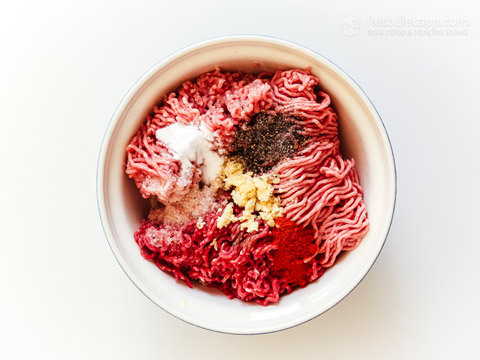
Mix until well combined so the flavor is uniform for all sausages.
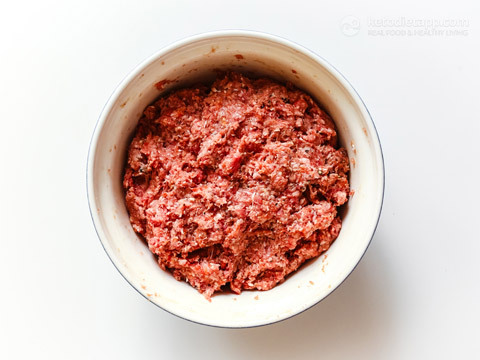
Using your hands, shape the mixture into flat, finger-length sausages, each about 50 g (1.8 oz) and 1 1/2 cm (1/2-inch) thick. Although you can make them into thicker, round sausages, flatter sausages are easier to cook through.

Preheat a griddle pan or a grill. Cook undisturbed for 4-5 minutes until a crust forms. Flip the sausages and cook the other side for another 4-5 minutes. Ensure they are no longer pink in the center. An instant-read thermometer inserted into the center should read 160��F (70��C).
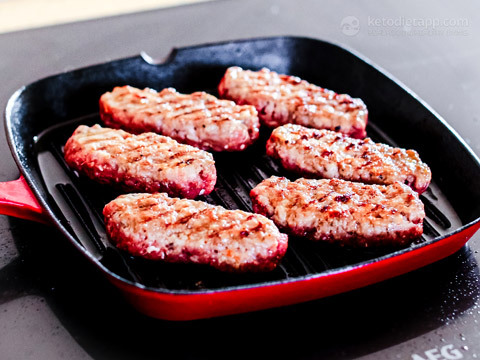
When done, transfer the sausages to a plate and serve immediately. Alternatively, let them cool to room temperature and store in an airtight container in the fridge for up to 4 days. For longer storage, freeze the sausages for up to 3 months.

Serve with fresh summer salads and/or some Ajvar Dip!

June 15, 2024
Ajvar Dip (Roasted Red Pepper Sauce)

Ajvar Dip is a beloved favorite in Balkan cuisine, known for its rich history and simple preparation. This tasty spread comes from the Balkan Peninsula and uses just a few key ingredients and a straightforward technique.
Made primarily with roasted red peppers and eggplant, it has a smoky, flavorful taste that's super versatile and easy to whip up. With its minimal ingredients and no-fuss process, traditional Ajvar Dip really lets the natural flavors shine, making it a hit for both everyday meals and special gatherings.
What Makes This Ajvar Dip the Best
First of all, this recipe has been trialed and tested for years! I've made it frequently for barbecues, and it's always a hit with friends.
Charring the peppers and eggplant under the broiler is key because it gives the dip that deep, smoky flavor that���s essential for authentic Ajvar. Plus, removing the skins from both the peppers and eggplant ensures a smooth, creamy texture and eliminates any bitterness or toughness. These steps might seem small, but they make a huge difference in achieving the perfect Ajvar Dip.
Recipe Tips and Swaps
This dip is naturally low in carbs, keto, dairy-free, nut-free, vegetarian, and vegan. Plus, it's made with heart-healthy extra virgin olive oil and is Whole 30 and Mediterranean-keto approved!
Here are easy swaps and tips for your Ajvar Dip:
Vinegar Swap: Instead of white wine vinegar, you can use apple cider vinegar (same amount), or fresh lemon juice (double the amount) for a slightly different but equally delicious tang.
Roasting Technique: For the best flavor, make sure to char the peppers and eggplant until they have a nice, blistered skin. This adds a deep, smoky taste that���s characteristic of traditional Ajvar.
Peeling the Vegetables: Cover the roasted vegetables with a damp cloth or place them in a sealed container to steam for a few minutes. This makes peeling the skins much easier.
Blending: Process the ingredients until smooth and creamy for the best texture. If you prefer a chunkier dip, pulse the blender a few times instead of blending continuously.
Storage: Ajvar can be stored in the fridge for up to a week or frozen in ice cube trays for longer storage. When ready, let it defrost in the fridge overnight. This way, you can enjoy it whenever you like!
How Do You Eat Ajvar Dip?
Ajvar is incredibly versatile and can be enjoyed in a variety of ways:
As a Dip: Perfect for dipping vegetables, with a slice of toasted quick keto bread, or crackers.
As a Sauce: Use it as a flavorful sauce for grilled meats, fish, or vegetables.
As a Spread: Spread it on a slice of keto bread, use in sandwiches, burgers, or lettuce wraps for a tasty twist.
In Pasta and Pasta Alternatives: Mix it into zucchini noodles or other low-carb pasta alternatives.
With Salads: Drizzle over salads for an extra burst of flavor.
As a Marinade: Marinate chicken, pork, or vegetables before grilling or roasting. It will go well with these Greek Chicken Skewers!
Just Like Ketchup: Enjoy it with keto french fries or as a condiment with other dishes.
In Tortilla Wraps: Use it as a filling for low-carb tortilla wraps for a quick and delicious meal.

Preparation time
Hands-on: 15 minutes
Overall: 45 minutes
Nutritional values (per serving, 1/4 cup, 60 ml)
Total Carbs5.2grams
Fiber1.9grams
Net Carbs3.3grams
Protein0.9grams
Fat9.2grams
of which Saturated1.3grams
Energy105kcal
Magnesium11mg (3% RDA)
Potassium179mg (9% EMR)
Macronutrient ratio: Calories from carbs (13%), protein (3%), fat (84%)
Ingredients (makes about 3 cups/ 700 ml)
6 medium red bell peppers (720 g/ 1.6 lb)
1 medium eggplant (250 g/ 8.5 oz)
4 cloves of garlic
1/2 cup extra virgin olive oil, divided (120 ml/ 4 fl oz)
1 tbsp white wine vinegar (15 ml) or 2 tbsp fresh lemon juice
Optional: red chile pepper flakes, or fresh chile pepper for heat
1 tsp sea salt, or to taste
1/2 tsp black pepper, or to taste
Instructions
Preheat the oven to 220 °C/ 430 °F (fan assisted), or 240 °C/ 465 °F (conventional). Place whole bell peppers and eggplant in a tray. Bake for 15 minutes.
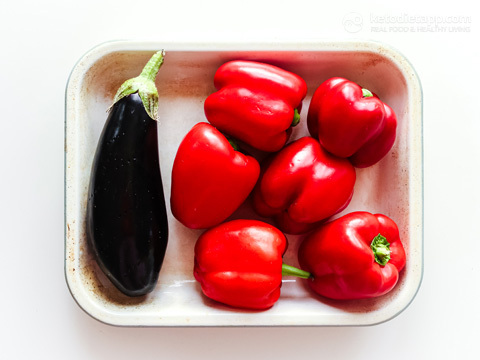
Reduce the oven temperature to 200 °C/ 400 °F (fan assisted), or 220 °C/ 425 °F (conventional). Continue baking for another 20 minutes, or until the peppers have charred blisters and the eggplant is soft.
Remove the tray from the oven and set the vegetables aside to cool. Cover them with a damp cloth or another tray to make peeling easier.

While the vegetables are cooling, peel and finely chop the garlic. Heat a tablespoon of olive oil in a pan over medium heat. Add the chopped garlic and saut�� for about 30 seconds, until fragrant.
Once cooled, peel the skins off the peppers and remove the seeds and stems. Transfer the peeled peppers to a blender. For the eggplant, make a large slit and scoop out the flesh with a spoon. Add the eggplant flesh to the blender. Discard the peels, stems and any excess juices.

To the blender, add the saut��ed garlic, vinegar (or lemon juice), the remaining olive oil, sea salt, and black pepper.

Process until smooth and creamy. Pour the blended dip into a storage container. Once it has cooled to room temperature, seal the container and refrigerate for up to a week. For longer storage, pour the dip into ice cube trays and freeze. Once frozen, pop the cubes out and store them in a freezer bag.
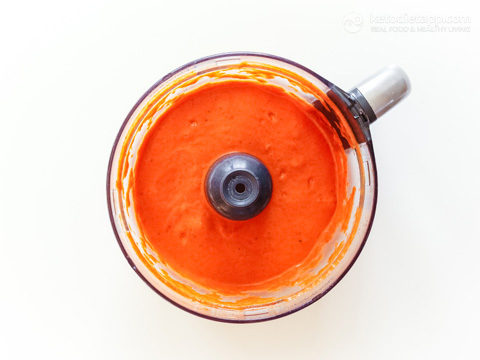
Serve as a dip with a slice of toasted quick keto bread, or crackers, with meat skewers, or in lettuce wraps.
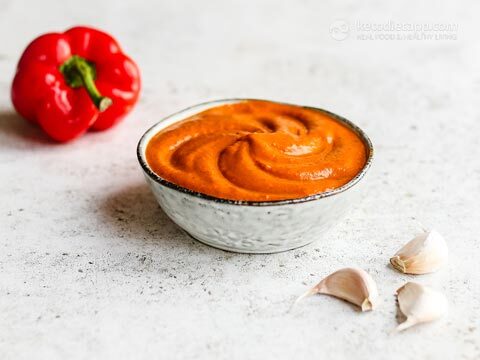
June 1, 2024
Why Pairing Keto with Fasting Is the Game-Changer You Need

Combining a ketogenic diet with intermittent fasting sets you up for success by making it easier to manage hunger and maintain steady energy levels. When you���re in ketosis, fasting becomes less of a struggle because your body���s already used to burning fat for energy.
Adding fasting to your keto lifestyle cranks up the fat-burning and could even sharpen your mind and extend your life. It's not just about losing weight; it's about enhancing your overall health and feeling great while doing it.
Jumping into fasting doesn't have to be tough. Start with shorter fasting periods and keep hydrated to ease your body into it. Listening to your body is key���adjust as you go to find what works best for you.
Our app is here to help you merge keto and fasting smoothly. Track your fasting, monitor your progress, and get the guidance you need every step of the way. Whether you���re a beginner or looking to step up your game, our app supports your journey toward better health.
PLUS you can get our annual KetoDiet App membership 25% off - click here to claim yours!
Table of Contents
Why Keto Enhances Fasting
Why Fasting on Keto Might Be More Effective
Fat Burning Supercharged
Steady Energy
Enhanced Brain Health
Increased Longevity
How To Integrate Fasting into Keto
1. Choosing the Right Time to Start
2. Start with Gentle Fasting Windows
3. Stay Hydrated
4. Monitor Your Body���s Response
5. Break Your Extended Fast Gently
Ready To Take Keto To the Next Level?
Coming Soon to iOS and Android!
Have you ever thought about pairing a ketogenic diet with intermittent fasting? This combo might be just what you need to boost your health. Let���s see why these two might work so well together.
Why Keto Enhances Fasting
When you combine intermittent fasting with a ketogenic diet, managing hunger becomes a whole lot easier. Why? Because keto switches your body���s fuel source from carbs to fats, meaning you start using fat for energy even before your fast begins. ( Paoli et al, 2015)
One of the common struggles with fasting is dealing with hunger pangs that strike when your blood sugar dips. But here���s the kicker: being in ketosis helps keep your blood sugar levels stable, which cuts down those hunger pangs. ( Gibson et al, 2015) This means you can go about your fasting period without the constant battle against cravings and fatigue, making it easier to stick to your fasting plan.
Plus, ketosis boosts the hormone cholecystokinin (CCK), which keeps you feeling full longer. This is super helpful during fasting, as it naturally reduces the urge to snack and helps extend your fasting periods with less discomfort. ( Paoli et al, 2015)
Why Fasting on Keto Might Be More Effective
So why consider fasting if you're already following a keto diet? Combining these two can take your health journey to a whole new level. Here���s how:
Fat Burning Supercharged
On keto, your body is already using fat as its main fuel source. When you add fasting to the mix, you amplify this fat-burning process. This not only aids in weight loss but also helps maintain it over time. By combining keto with fasting, you're tapping into your fat stores even more efficiently, especially during periods when you're not eating. ( Anton et al., 2018)
Steady Energy
One major bonus of keto-fasting is the stable energy levels. Since both keto and fasting help maintain low and stable insulin levels, you avoid the big spikes and drops in energy that carbs often cause. This stability can make it easier to focus and stay active, without the crashes that make you reach for a snack. ( Johnstone, 2015)
Enhanced Brain Health
There���s also something cool about how this combination impacts your brain. Studies suggest that the combination of ketosis and fasting can lead to better brain health and improved mental clarity. This is because both practices are known to increase the production of a brain chemical called BDNF, which helps with learning and memory. ( Mattson et al., 2016)
Increased Longevity
Research is starting to show that the benefits of keto combined with fasting might even extend your lifespan. This is because both practices can improve markers of health like blood sugar control, inflammation reduction, and heart health, which are all linked to longer life. ( Wei et al., 2017)
How To Integrate Fasting into Keto
Merging intermittent fasting with the ketogenic diet doesn���t have to be complicated. Here are some quick tips to help you get started and make the most out of combining these two powerful health strategies.
1. Choosing the Right Time to Start
If you���re new to keto, don't rush it! Give your body a couple of weeks to adjust to this new way of eating before you introduce fasting. This allows your body to get used to burning fat for fuel first, which can make the transition to fasting smoother and more manageable.
2. Start with Gentle Fasting Windows
Begin with shorter fasting periods that feel manageable. A popular approach — and a great way to start — is the 16/8 method, where you fast for 16 hours and eat within an 8-hour window. For example, you might choose to eat between 12 p.m. and 8 p.m., or 10 a.m. and 6 p.m. These schedules can work well with your natural hunger cues while on keto.
3. Stay Hydrated
Drinking plenty of water is crucial, especially during your fasting periods. Hydration helps curb hunger and maintains your energy levels. Don���t forget to include electrolytes like sodium, potassium, and magnesium, which are vital for preventing symptoms of the "keto flu.". Apart from electrolyte drinks and supplements, you can have some bone broth or chicken stock.






4. Monitor Your Body���s Response
Pay attention to how your body reacts. Everyone���s different, and what works for one person might not work for another. If you feel overly tired or irritable, it might be a sign to adjust your fasting window or what you���re eating during your meals. You might want to start with a gentle fast, such as 14/10, during which you'll fast for 14 hours and have a 10-hour feeding window. For example, you might choose to eat between 10 a.m. and 8 p.m.
5. Break Your Extended Fast Gently
When you���re coming off a long fast, such as over 24 hours, it's best to take it slow with your first meal. Your digestive system might be a bit delicate after the break, so starting with something light and easy to digest is key. Think about having a small salad, or maybe a few steamed veggies with some olive oil and salmon. Keep it keto-friendly with high-protein choices. Ease back into your regular meals gradually to keep things comfortable.
Ready To Take Keto To the Next Level?
If you���re looking to really ramp up your health, our app���s new features are just what you need. Here���s a sneak peek at what���s new:
Easily Track Your Fasts: Pick from popular fasting methods like OMAD or 16/8 right in the app. It���s perfect for both newbies and seasoned fasters.
See Your Progress Instantly: Keep tabs on how you���re doing with a fasting counter right on your home screen. It���s a great motivator and makes it super easy to stick to your goals.
Fasting Milestones in Real Time: Depending on the fasting window you choose, you will see exactly when you'll be entering ketosis, fat burning, and autophagy.
Guidance Every Step of the Way: New to fasting? We���ve got you covered with step-by-step guides to help you before, during, and after your fast.
This is only version one, but we���re already cooking up even more cool features based on what you tell us you want to see next. Your feedback is invaluable, so let us know what you���d like to see next by joining our Facebook group!
���� PLUS you can now get our annual membership 25% off - click here to claim yours!
Coming Soon to iOS and Android!
We're thrilled to announce that this feature is available on iOS. To our Android users, we understand your eagerness and appreciate your patience! As a small team, developing, testing, and releasing quality features takes time (a LOT of time), but we are working hard to bring the Android version to you as soon as possible.
Whether you���re looking to break through plateaus, enhance your health, or simply manage your dietary habits better, our app is here to help. Get ready to take control of your health with the latest in keto and fasting technology!
May 16, 2024
No Bake Keto Peanut Butter & Chocolate Cheesecake

Guess what? I've got another fantastic crustless keto cheesecake recipe for you! If you've been around here for a while, you know how much everyone loves these easy, no-bake treats.
Today, we're mixing it up with something truly special: a No-Bake Keto Peanut Butter Chocolate Cheesecake. It's all about that dreamy combination of chocolate and peanut butter���because, let's be honest, who can resist that?
Recipe Tips and Ingredient Swaps
Love this recipe but need to tweak it to suit your diet or what you���ve got in the pantry? No problem! Here���s how you can swap out ingredients to make this cheesecake work for you:
Sweetener Options: If Allulose isn���t your thing or you just don���t have it on hand, you can easily substitute it with another low-carb sweetener like erythritol or stevia. Just keep an eye on the sweetness level, as each sweetener has its own sweetness potency.
Gelatin-Free Option: For a vegetarian version of this cheesecake, you can replace gelatin with agar powder or flakes. Use 1 teaspoon of agar powder or 1 tablespoon of agar flakes to substitute for the 1 1/2 teaspoons of gelatin powder. Agar needs to be boiled to activate, so make sure to simmer it with a small amount of water for about 5 minutes before adding it to your recipe.
Cream Cheese Alternatives: Not a fan of cream cheese or need something dairy-free? Mascarpone cheese is a great swap if you���re still doing dairy. For a dairy-free version, try using coconut cream instead of cream cheese, and coconut milk instead of whipping cream.
Peanut-Free Option: If you���re allergic to peanuts or just want a different flavor, almond butter is a fantastic alternative. It will give you a similar creamy texture with a twist in taste.
Nut-Free Option: Need to keep it nut-free? Swap the peanut/almond butter for tahini, which is sesame seed-based and gives a unique flavor that pairs wonderfully with chocolate. Have a sesame seed allergy too? Another option is to use sunflower seed butter.
Chocolate Options: I use 90% dark chocolate to keep it low-carb, but if you prefer something a bit different, any sugar-free chocolate will do the trick. 85% dark chocolate is also a good option. Just make sure it fits into your carb count!
With these swaps, you can still enjoy this creamy, dreamy cheesecake!
Recipes You'll Love
Craving more? Check out these easy, no-bake keto cheesecake recipes���simple, delicious, and perfect for any keto diet!
No Bake Keto Dulce De Leche Cheesecake
No Bake Keto Pumpkin Cheesecake
No Bake Keto White Chocolate & Raspberry Cheesecake
Keto Chocolate & Mint Cheesecake Fluff
Fluffy Keto Strawberry Cream

Preparation time
Hands-on: 15 minutes
Overall: 2 hours
Nutritional values (per serving, about 115 g/ 4 oz)
Total Carbs7grams
Fiber1.8grams
Net Carbs5.2grams
Protein7.6grams
Fat40.2grams
of which Saturated21.3grams
Energy408kcal
Magnesium51mg (13% RDA)
Potassium246mg (12% EMR)
Macronutrient ratio: Calories from carbs (5%), protein (7%), fat (88%)
Ingredients (makes 8 servings)
3 tbsp water (45 ml)
1 1/2 tsp gelatin powder
2 cups heavy whipping cream (480 ml/ 16 fl oz)
1/3 cup Allulose or other granulated low-carb sweetener (g/ oz)
1/2 cup full-fat cream cheese or mascarpone cheese (g/oz)
1 tsp sugar-free vanilla extract or vanilla bean powder
pinch of sea salt
1/2 cup peanut butter (g/oz)
70 g 90% dark chocolate (2.5 oz)
Instructions
Break the chocolate into pieces and place it in a heatproof bowl over a small saucepan filled with about a cup of water. Melt the chocolate over medium heat, ensuring that the bowl does not touch the water but is heated through steam. Once melted, remove from heat and allow to cool.
Gently heat the peanut butter (on the stove or in a microwave), stirring until it is smooth and lump-free.
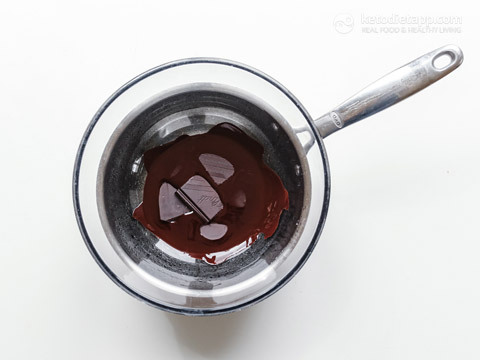
In a small cup or bowl, sprinkle gelatin over 3 tablespoons of cold water and let stand for a few minutes to soften.
Heat half of the cream in a saucepan with all of the sweetener over medium-low heat until the sweetener dissolves. Do not bring to a boil. Once hot, add the softened gelatin and stir until dissolved. Remove from heat and allow to cool to room temperature.
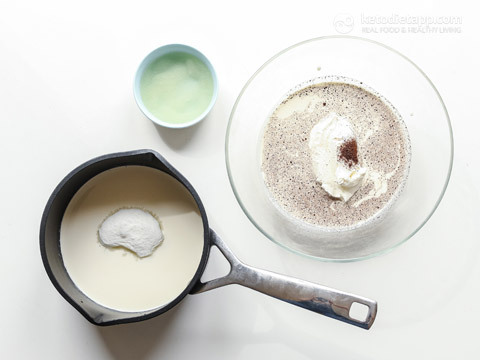
Combine the remaining cream, cream cheese (or mascarpone), vanilla extract (or powder), and salt in a bowl. Using an electric mixer, whip until fluffy.

Gradually pour the cooled sweet cream mixture into the bowl of whipped cream while continuing to mix.
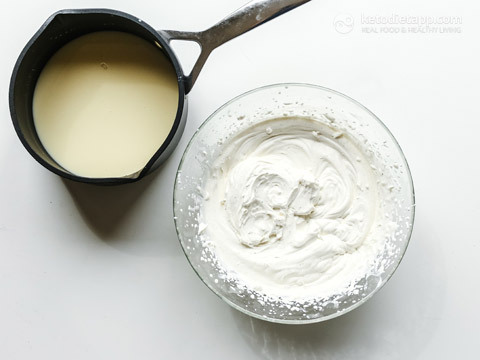
Divide the mixture into two equal parts.
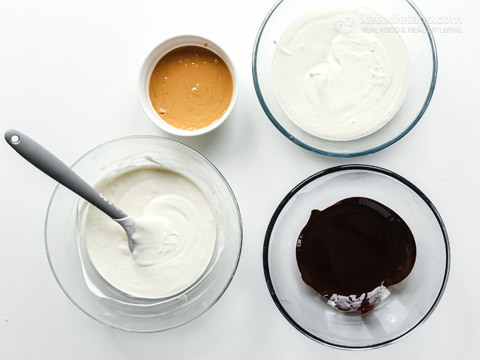
To one part, add the melted chocolate and mix until smooth. To the other, add the softened peanut butter and mix until smooth.

Pour the chocolate mixture into a pie dish. Spoon the peanut butter mixture into various parts of the dish. Using the back of a spoon, gently swirl the two mixtures together to create a marbled effect.
Refrigerate the cheesecake for at least an hour or until it is fully set.
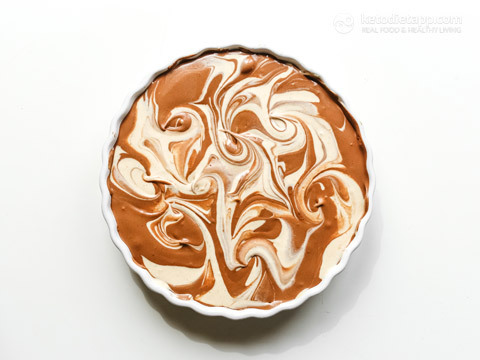
Serve chilled, optionally drizzled with softened peanut butter, topped with grated dark chocolate, or whipped cream. Store in the refrigerator for up to 5 days.

May 7, 2024
Air Fryer Sardine Egg Cups

Looking for a quick, easy and budget-friendly meal that uses just a few kitchen staples? Try whipping up some air-fryer egg cups!
These Sardine Egg Cups, crafted from just four main ingredients, are not only low in carbs and high in protein, but they're also rich in electrolytes and healthy fats���ideal for a Mediterranean keto diet.
Fun fact: This recipe didn't make it into my New Mediterranean Diet Cookbook. We just had too many recipes and very strict page count so I'll be sharing more with you here instead!
So whether you���re cooking for a crowd or meal prepping for the week, these egg cups are a breeze to adjust in quantity. Typically, one to two egg cups suffice for a serving, especially when paired with fresh avocado, tomatoes, or bell peppers.
Craving a protein boost or simply love bacon? Give our classic Bacon & Cheese Egg Cups a go for your next breakfast! Need a vegetarian option? Make these Spinach & Feta Egg Cups!
Don't Have an Air Fryer?
If you don't have an air fryer, simply bake these in the oven. To do that bake the cups at 200 °C/ 400 °F (fan assisted), or 220 °C/ 425 °F (conventional) for 10 to 15 minutes (depending on whether you prefer softer or fully set egg yolks).

Preparation time
Hands-on: 5 minutes
Overall: 10 minutes
Nutritional values (per serving, 1 egg cup)
Total Carbs3.4grams
Fiber0.8grams
Net Carbs2.6grams
Protein13.9grams
Fat14grams
of which Saturated2.8grams
Energy195kcal
Magnesium27mg (7% RDA)
Potassium366mg (18% EMR)
Macronutrient ratio: Calories from carbs (5%), protein (29%), fat (66%)
Ingredients (makes 2 egg cups)
2 to 4 canned sardines (57 g/ 2 oz)
2 large pieces of sun-dried tomatoes, chopped (20 g/ 0.7 oz)
1 medium spring onion, sliced (15 g/ 0.5 oz)
2 large eggs
sea salt and red pepper flakes, to taste
2 tsp extra virgin olive oil
Instructions
Chop the sun-dried tomatoes and roughly chop the sardines.

Divide the sardines, sun-dried tomatoes and spring onions between two ramekins (at least 3/4 cup/ 180 ml capacity). Crack an egg into each cup and sprinkle with salt. Drizzle each with a teaspoon of olive oil and sprinkle red pepper flakes.
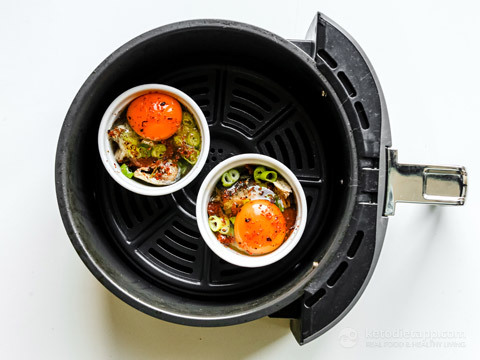
Place in the air fryer and cook at 200 °C/ 400 °F for 5 to 7 minutes (or less for softer yolks).

Remove from the air fryer and let the cups cool down for a few minutes before serving. Optionally, serve with more spring onion, sliced avocado, tomatoes, bell peppers, and/or more olive oil on top. Eat warm or cold, or store in the fridge for up to 3 days.

March 23, 2024
Cottage Cheese Berry Protein Smoothie

This high-protein smoothie offers a refreshing and easy low-carb breakfast alternative. While not strictly "keto," it remains low in carbs and, with its high protein content, keeps you full longer���making it an excellent choice for busy mornings. It's the ideal second meal option for those who practice intermittent fasting.
The smoothie gains its extra protein punch from cottage cheese and collagen powder. Cottage cheese, a surprising but effective ingredient in smoothies, creates a smooth, frothy texture without any aftertaste, ensuring its presence is undetectable once blended.
For an added boost, magnesium powder is included to enhance electrolyte balance, promoting energy and hydration throughout the day.
How To Make Cottage Cheese Protein Smoothie
This Cottage Cheese Berry Protein Smoothie is so easy to make. You'll only need a few ingredients:
Cottage Cheese: The cornerstone of this recipe, it ensures a creamy, high-protein smoothie without any aftertaste.
Collagen powder: Boosts the protein content and adds to the smoothie's creaminess. Options include plain or sugar-free flavored collagen, such as Vanilla Collagen Peptides from Perfect Keto. Alternatively, whey protein powder (isolate) or egg white protein powder can be used.
Cashew Milk: Unsweetened cashew milk, almond milk, or even water are suitable (although not ideal as it lacks potassium). For a nut-free version, try Poppy Seed Milk or Coconut Milk (light).
Berries:Frozen berries add creaminess and versatility. Choose from strawberries, raspberries, blackberries, or wild blueberries for a flavorful smoothie.
Magnesium Powder: Provides an electrolyte boost. Neutral tasting options like Natural Calm work well, or for added flavor, Raspberry-Lemon Calm can be used.
Low-Carb Sweetener (optional): To adjust sweetness, stevia or Allulose are recommended, with a variety of options and conversions available here.
Vanilla Extract (optional): Not necessary if using flavored collagen powder.

Customize Your Smoothie
Each and every one of us has different dietary needs so it's only natural that you may need to adjust the macros in this smoothie recipe. Here are a few tips:
Need more fat/calories? Add a tablespoon of MCT oil or some heavy whipping cream.
Need less protein? Skip the collagen powder.
Need fewer carbs? Use blackberries for a slightly lower carb count.
You can make all these adjustments and more directly in the KetoDiet App by cloning any of the recipes from my blog and customizing them to fit your own macros and preferences.
More Keto Smoothie Recipes
Love low-carb smoothies? Check out some of these recipes:
Keto Peanut Butter & Chocolate Smoothie
Vanilla Keto Smoothie
Chocolate Keto Smoothie
Keto Strawberry & Basil Smoothie
Keto Blueberry Breakfast Smoothie
Keto Blackberry Cheesecake Smoothie
Creamy Keto Green Smoothie
Raspberry & Lemon Protein Smoothie
Preparation time
Hands-on: 5 minutes
Overall: 5 minutes
Nutritional values (per serving, 1 smoothie)
Total Carbs19grams
Fiber3.9grams
Net Carbs15.1grams
Protein44.6grams
Fat16.3grams
of which Saturated4.7grams
Energy391kcal
Magnesium237mg (59% RDA)
Potassium768mg (38% EMR)
Macronutrient ratio: Calories from carbs (16%), protein (46%), fat (38%)
Ingredients (makes 1 serving)
3/4 cup cottage cheese (170 g/ 6 oz)
1 1/4 cups unsweetened cashew milk or almond milk (300 ml/ 10 fl oz)
3/4 cup mixed frozen or fresh berries (113 g/ 4 oz)
1 tsp Natural Calm or Raspberry-Lemon Calm (magnesium powder)
1/4 cup collagen powder, plain or vanilla or protein powder of choice (25 g/ 0.9 oz)
Optional: 1/2 tsp sugar-free vanilla extract (if using plain collagen powder)
Instructions
Prepare all the ingredients for your smoothie. If using fresh berries, wash under running water.
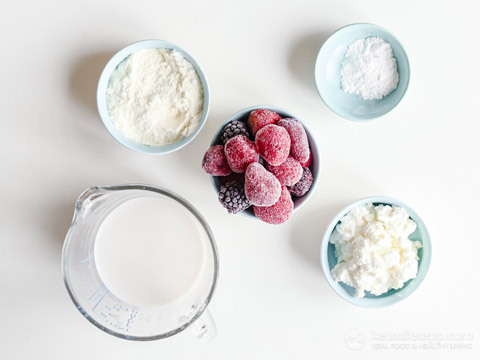
Place all the ingredients in a blender: cottage cheese, berries, almond milk (or nut/seed milk of choice), collagen powder (plain or vanilla) and magnesium powder. If using plain collagen powder, optionally add vanilla extract and/or low-carb sweetener of choice.

Process until smooth and frothy.
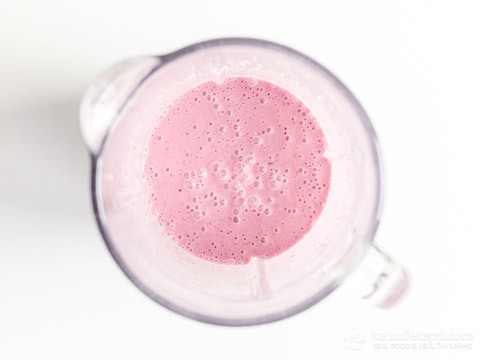
Serve immediately. You could store the prepared smoothie in a sealed jar in the fridge for up to a day. Shake before serving.

March 15, 2024
Green Spring Cheese Omelet

Spring into the season with this quick and vibrant Green Spring Cheese Omelet that brings a splash of color to your brunch table. Perfect for Easter, St Patrick's Day, or any day when you want to add a little greenery to your plate!
The bell pepper rings mimic shamrock shapes, making each bite a little lucky charm, just like these Shamrock Eggs! Not only is this dish a feast for the eyes, but it's also a nutritional powerhouse, ticking all the boxes for a low-carb, keto, and high-protein diet.
Plus, it's so easy to whip up ��� it'll be ready faster than you can find a four-leaf clover!
Recipe Tips, Swaps, and Variations
This omelet is as versatile as it is delicious. If you're not a fan of Parmesan, or need to make this recipe vegetarian, try goat's cheese for a tangy twist or crumble some feta for a Mediterranean vibe.
Want to freshen it up? Throw in a handful of spinach or a few mint leaves for an extra herby punch.
And for those of you looking for a protein boost ��� a ribbon of smoked salmon will transform this into a meal fit for a leprechaun king!
Remember, the beauty of this recipe lies in its simplicity and flexibility. Don't hesitate to play with ingredients ��� your omelet, your rules! Whether you're gearing up for a spring picnic or just starting your day, this Green Spring Cheese Omelet is bound to put a pep in your step.

Preparation time
Hands-on: 10 minutes
Overall: 15 minutes
Nutritional values (per serving, one omelet)
Total Carbs5.5grams
Fiber1.6grams
Net Carbs3.9grams
Protein28.2grams
Fat33.7grams
of which Saturated10.3grams
Energy440kcal
Magnesium40mg (10% RDA)
Potassium403mg (20% EMR)
Macronutrient ratio: Calories from carbs (4%), protein (26%), fat (70%)
Ingredients (makes 1 servings)
2 rings green bell pepper (40 g/ 0.7 oz)
3 asparagus spears (36 g/ 1.3 oz)
1 tbsp extra virgin olive oil
3 large eggs
1/4 cup grated Parmesan (23 g/ 0.8 oz)
1 tbsp chopped chives
pinch of salt and pepper
few sprigs of dill
Instructions
Cut two 1/2 inch (1 cm) slices of green bell pepper. Chop the chives and tear the dill into smaller sprigs.
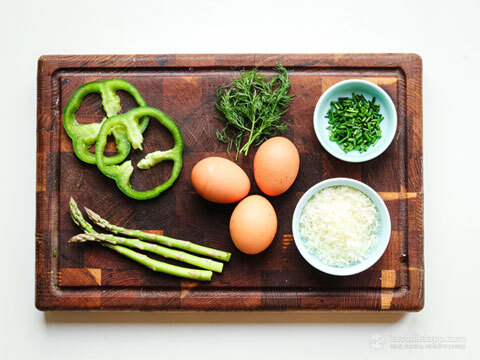
Heat a large skillet greased with olive oil over a medium-high heat. Add the pepper slices and cook for 3 to 4 minutes, turning halfway. When crisp-tender, transfer to a plate.

While the veggies are cooking, crack the eggs into a bowl. Add grated cheese and chopped chives. Season with a pinch of salt and pepper. Whisk using a fork.
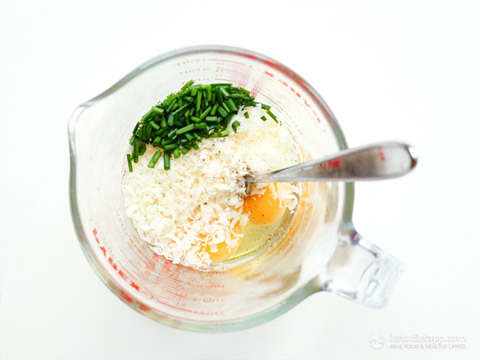
Pour the egg mixture into the hot pan where you cooked the veggies. Use a spatula to bring in the egg from the sides towards to centre for the first 30 seconds.
Turn the heat down to medium. Carefully add the cooked pepper rings and asparagus spears. Sprinkle with fresh dill. Cook for 2 to 3 minutes, or until set underneath.

Serve warm or let the omelet cool down to room temperature and refrigerate for up to 3 days.
